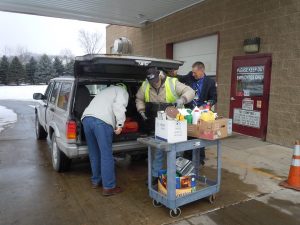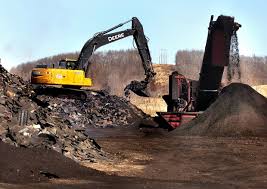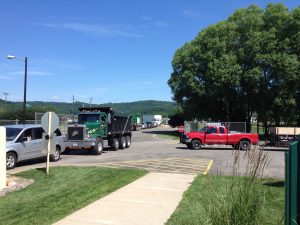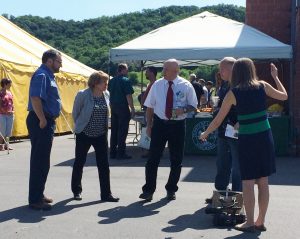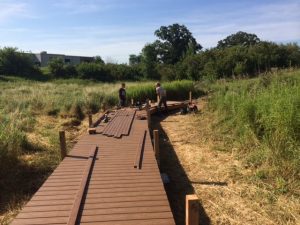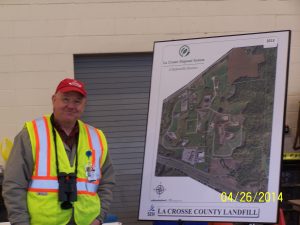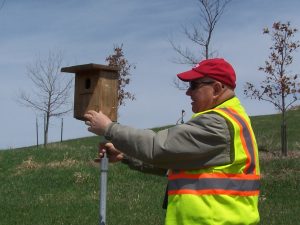Through turning every kind of waste into a resource, partnering with environmental organizations and developing the land into a natural resource, the La Crosse County Landfill has made it their mission to transition the facility into an asset for the community.
Nestled on 350 acres against a bluff within the city limits of La Crosse, Wisconsin, lies the county landfill looking down into the La Crosse River Valley as it enters the Mississippi River Valley. When the landfill originally opened in 1978, it was a typical landfill that didn’t have a liner and it leaked. So in the mid-1990s, a new site with a Subtitle D liner was built at the complex. In 1988, waste-to-energy (WTE) was added as part of the La Crosse system, when the county entered into a long-term contract with Northern States Power, now known as Xcel Energy. As a refuse-derived fuel, waste-to-energy facility and with a contract in place that runs through 2023, 75,000 tons per year of primarily municipal solid waste that local haulers collect from residential areas go to the WTE plant where it is burned for energy. An additional 100,000 tons of waste that cannot be processed at the WTE facility, such as demolition materials or foundry sand, are typically disposed of in the landfill.
The La Crosse County Landfill is the hub of a regional solid waste system that primarily serves the Wisconsin counties of Buffalo, Trempealeau and La Crosse as well as the bordering counties of Houston and Wabasha in Minnesota. The landfill also accepts waste from parts of Jackson County and Winona County and others on the edge of the service area. Regional participants in the system are represented on the La Crosse County Solid Waste Policy Board, which oversees the landfill.
Fixing an Original Problem
Until the early 1990s, the old county landfill had no liner. Leaks affected nearby groundwater, so La Crosse County leaders were faced with a dilemma—there was not sufficient additional space on the property to develop a third a landfill expansion. “Our leaders had a very open discussion about our old site and the fact that it was leaking. As a group everyone agreed ‘let’s take care of this without having a solution dictated by regulators’. We had sufficient funds for an alternative approach that would resolve the issues with the old landfill, give us long-term expansion on the property and save us money,” says Henry Koch, P.E., La Crosse County Solid Waste Director.
The traditional approach to clean up the old landfill was to re-contour it, pump and treat groundwater, and take other remedial actions at a projected cost exceeding $45,000,000. The County would then need to site a new landfill with permitting, public relations and new infrastructure projected to cost an additional $15,000,000. The alternative approach was to “recycle” the old landfill at a cost of about $12,000,000. It involved digging up the old site and obtaining an expansion permit over the old site which cost $5,000,000. “It was a no brainer,” says Koch.
The county chose to do the site remediation over two winters in 2005 and 2008 to minimize odors. Garbage and soil in the old landfill was excavated, along with two feet of soil below the garbage. Sampling was conducted at 100-foot centers to make sure there weren’t any additional contaminants in the soil. If contaminated soil was found, it was also removed and put it into the new, fully lined site.
“We saw there was a liability for our customers if we didn’t take action, so we dug up our old 31-acre landfill and put the waste and soil into an upgraded area with a subtitle D liner. That in turn extended our landfill capacity to 27 years and we have the ability to expand our site another 10 to 20 years on our current property,” says Koch. “The project was finished in 2009. We saved ourselves a ton of money and in the long-term it was a better form of remediation than just putting a band-aid on some of the problems we had.”
Building and Refining a Waste-to-Energy Solution
Sixteen miles away from the landfill on French Island in the Mississippi River is Xcel Energy’s WTE facility. In the 1980s, the local leaders saw how fast the landfill was filling, and wanted to explore a better way to take care of the waste. Wanting to see more recycling, they approached the state of Wisconsin and expressed their wishes. However, Wisconsin was not ready to put recycling laws on the books at that time. The next suggested alternative was WTE—a solution that involved less consumption of landfill air space and provided beneficial energy production. After reviewing multiple proposals the county entered into a contract with the local utility, Northern State Power. The company committed to installing an RDF operation, converting the existing plant’s boilers to fluidized bed boilers to handle the refuse and share energy credits. “It was a very attractive proposal to us and that is how we got into WTE. There were times, in the beginning where we weren’t delivering the volume of waste required, and that helped us do a better job regionalizing solid waste services our area,” says Koch.
“We also worked with environmentalists, citizens and others who were concerned about the emissions from the WTE plant. They sued and won, saying the plant should be regulated as a large combustor. As a result of that, we worked with Xcel to change some things at the facility including a $10,000,000 retrofit. That actually helped, in that we are now ahead of what is being required at other facilities. All of those challenges made us stronger.”
At the WTE facility, Xcel has installed ferrous magnets to recover metal and eddy current magnets to recover aluminum. Koch explains that while the city of La Crosse has a good single stream recycling program and an excellent MRF built by a private enterprise, some citizens still put their cans (aluminum and ferrous) in the regular trash.
With the installation of the magnets, about 900 tons per year of ferrous material and 265 tons of aluminum material are salvaged. Although aluminum is only 3/10 of a percent of the waste stream at Xcel and most people think that is inconsequential, the revenue for the recovered material, split between the county and Xcel, provides $140,000 in annual revenue to the county. “It puts recycling into a different perspective—even when we are doing a good job, there is still a certain percentage of valuable material that is getting by. In the La Crosse system we have a ‘safety belt’– we can capture it at our WTE plant. If you go to any other community in Wisconsin, they can have a great recycling program, but a similar amount of aluminum and steel is still buried in their landfills,” says Koch. Unfortunately, because the aluminum cans recovered at French Island are dirtier than those separated at the MRF the material doesn’t have the same value as the MRF material. To resolve this issue, Xcel found a recycler in Minneapolis who will clean and recycle these products.
Collecting Household Hazardous Waste
This year, the La Crosse County Household Hazardous Materials (HHM) program has collected over 1,000,000 pounds of materials. Employees at the county’s permanent HHM facility sort the collected household products. Items that are properly packaged and in good shape, around 50,000 pounds per year, are offered free to the public at the HHM facility’s reuse room. Other materials are properly transported and disposed of at an appropriate facility. The HHM program is funded through a tax of $2 per person.
Material such as household chemicals, fertilizers, used oil, batteries, and electronics can be dropped off at the facility. In addition, the Solid Waste Department conducts several “Clean Sweep” events in surrounding counties. “We also serve businesses that are classified as very small quantity generators, so if you’re a business and you’re a small quantity generator of hazardous materials, you can dispose of those for a fee at our facility. These are typically products not suitable for reuse, like a small printing shop that might have solvents,” Koch adds.
“If a material is not suitable for reuse, we’ll bulk it and ship it to a hazardous waste incinerator where it’s used as fuel. Herbicides and pesticides are also bulked and shipped to a hazardous waste disposal facility. Florescent bulbs are sent to a recycler/processer. For electronics, we do some rudimentary sorting and ship them to recyclers. All of this pre-sorting results in being able to get a little better price on the recycling disposal costs,” comments Koch.
Keeping the Value
With very few employees, the Solid Waste Department’s mission statement incorporates commitment to public-private partnerships. “Although the government is very good at providing oversight reflecting the values of the community, a private contractor is more beneficial to run the operation,” Koch explains.
“Safety to us is making sure that all of our contractors have safety programs, but we also have a separate consultant to go over our own safety programs, training and policies. For example, we have manholes and tanks on the site that require confined space entry. Ultimately, we made a policy decision to hire a contractor to take care of those elements because it is highly specialized. Doing this has simplified our safety programs and allowed us to concentrate on other safety issues such as traffic patterns on the site, safety around the scale and in the citizens area.”
Training is also conducted by private contractors. The state of Wisconsin requires landfill operators to be certified. The private contractor is required to provide training for certified operators. There must be a certified landfill manager at the landfill and La Crosse has four certified landfill managers who oversee the site. Koch says the county choose to have several people certified to ensure there is always a certified landfill manager at the facility.
He points out two important documents that guide the short and long-term operations of the landfill site. “We have an updated 2015 Comprehensive Solid Waste Management Plan that guides us for the next 20 years. We voluntarily update the plan every five years because the industry is changing that quickly,” Koch points out. “We won’t just run the landfill here for the next 27 years and then throw the keys on the desk of the County Board and say ‘okay we’re done, the property is yours’.”
“So we met with our neighbors, and a regional organization called the Outdoor Recreation Alliance that operates multi-use trails that run along the bluffs up and down the Mississippi River. All agreed the site is a hub from which many other trails can connect, so we developed a Landfill Master Land Use Plan which our county board approved. It says we are going to ecologically restore our site and develop walking trails and other recreational amenities on the property. We are not going to wait 27 years; we are doing it now.”
In addition, the landfill has worked with local Eagle Scout candidates on recreation and ecological projects on the site. This year the Eagle Scouts built a boardwalk to allow visitors to traverse a wetland on the property, as well as a snake hibernaculum that gives snakes a safe space to hibernate during the winter. Scouts have also installed birdhouses for hawks and screech owls. The overall ecological goals are to restore portions of the site to prairie, keep and enhance 90 acres of woodlands, and incorporate trails for hiking and mountain biking.
In the spring, the landfill hosts a cleanup event with local Cub Scouts. During the event, scouts and department staff talk about the site, how to properly manage waste and recycling materials, and work on environmental and ecological restoration projects.
Koch says the site has also hosted a Bio-Blitz, inviting more than 100 people to the landfill for an entire day. During the Bio-Blitz participants tour the whole property and note various species of plants, animals, insects and other specimens. The documentation creates a benchmark of site conditions and that information is included in the Master Land Use Plan. “One project we are currently working on is turning a sedimentation basin into a bear-shaped effigy mound—the head and the legs of the bear would form three sides in order to get the water to infiltrate the wetlands,” says Koch. “We approached the Ho-Chunk Nation and asked if we could do this because we wanted to do it with respect knowing that it is part of their culture. They are very excited because they think this will be a great educational tool.”
The Solid Waste Department lobbied hard to persuade Habitat for Humanity to locate its Restore outlet near the landfill site. “If you have usable construction materials, you can donate them to Habitat’s Restore and they will resell them. We have a part-time person in our citizen’s drop off area who watches for usable building materials or furniture delivered by citizens. We pull that material out and give it to the Restore,” explains Koch.
“Along with construction materials and furnishings, I can’t tell you how many bikes are thrown out. So we have arranged with a local bike company to restore and offer them to kids who don’t have bikes. We are constantly looking for ways to recover items that can be restored or recycled and offer them to the public in a fair and equitable manner. If we can give it to Restore or a charitable group that benefits the community, we will certainly do that.”
Fighting Through Challenges
The La Crosse County landfill is no stranger challenges. Koch says there are four big challenges facing the system, starting with efficiently integrating WTE. The landfill works with local haulers to help them understand what material should be delivered to the WTE facility and what should be delivered directly to the landfill. The staff also works with customers to help them better separate their waste and make sure it goes to the right destination. “The public perception of WTE in the US has been and continues to be a challenge. People equate WTE with burning trash and harming air quality. We continue to work on changing that perception.”
Another challenge is landfill gas-to-energy. “It seems like 200 to 400 tons of landfilled garbage per day should generate more than enough methane gas as it decomposes to support a gas-to-energy project,” says Koch. “But what’s happening in our system is the best residential garbage is used for fuel at the WTE facility. So our landfill gas production is less than half of what you see at other landfill sites. It was a challenge for us to design a landfill gas system and be able to pull enough volume to support it. Now the challenge is to enhance gas production on our site. We are exploring ways to incorporate more leachate recirculation in our operations in order to do that,” says Koch.
Another challenge with gas production is that the site accepts proportionately more construction and demolition material than a typical site. This includes drywall that contains gypsum. When that material decomposes it produces hydrogen sulfide gas—potentially harmful for gas-to-energy engines.
To address this challenge, Koch says fill phasing plans were changed. The operator now runs two separate areas, keeping demolition material in one area and garbage in the other. The gas systems in the garbage areas extracts a better quality of gas while pulling a little less from the demolition area. “Demolition material does not generate a lot of gas, but we are still required to put the gas wells in there. However, we can blend the two together so we are not upsetting the engine where the gas is being burned,” says Koch.
He laughs at an ironic challenge the county faces: putting themselves out of business. The landfill’s governing bodies, citizens and stakeholders all want the landfill to find more ways to divert waste; however, as more waste is diverted, revenue goes with it. Innovative programs, such as asphalt shingle recycling at the facility are providing a higher diversion rate. If shingles are removed from a roof and mixed with garbage, wood and paper they are placed in the landfill and the customer is charged $59 per ton. However, if the shingles are separated from other waste and are clean, the fee is only $30 per ton. The landfill can grind and sell them to an asphalt plant for reuse in asphalt road material. The site takes the same approach with clean wood. Pallets, clean crating and similar materials are ground and sold to Xcel as an additional fuel for the WTE facility. The landfill accepts clean concrete and asphalt for free, and grinds it for use on local roads and highway projects “We are looking at improving diversion of construction and demolition material. Even though we only get about 12,000 to 15,000 tons per year, we see an inordinate amount of steel and clean wood and would like to find a safe way it can be separated so the valuable portion can be diverted and recycled,” explains Koch. “The other thing we started in 2014 was a mattress recycling program. We divert some of our mattresses to a private contractor for recycling. Prior to this we buried 7,500 mattresses per year in the landfill.
“Next year, we are going to start charging $15 for a mattress or boxspring and that money will go towards the mattress recycling program. We believe this will be mandated in the future, so we decided to be proactive.”
“In the last two years, our system has been approached by several Fortune 500 companies like MillersCoors from outside our service area. These companies have adopted zero landfill policies, and are partnering with us to get their waste to the WTE facility where it can be beneficially reused to generate electricity,” Koch notes.
“We’ve been approached by customers who don’t want their waste to go to a landfill, who are willing to transport it quite a distance. I’m not sure that is the most sustainable approach, so we’ve worked with some customers, to arrange a “waste swap” where we take waste generated locally and those organization can put their waste in their local landfill. The companies can claim the credit for the waste swap. We’re seeing some interesting trends in that area.”
Changing the Public’s Perception
Despite these challenges, Koch is most proud of helping change the public’s perception of landfills. “A landfill is not a liability to a community, it is an asset. It’s not something to be shunned and pushed as far as possible into the rural area. We have seen a change in perception in the last five or six years and we measure it in the comments we receive from people.”
Every year, the Solid Waste Department conducts a stakeholders’ meeting. Last year 750 neighbors were invited, however, only about 20 attended. “At first it seemed like a failure. But we believe, and are told, we’re running such a good landfill site that people have faith in what we are doing. We’ve kept them informed so they didn’t feel the need to come to the meeting,” stresses Koch.
Giving back to the community has also helped shape new perceptions of the landfill. The department has conducted clean up events on the Mississippi River, provided free containers and waived collection and disposal costs in certain situations. Koch says this helps people understand the landfill doesn’t just collect disposal fees, they also give back.
The landfill provides tours to more than 1,000 people per year. Koch says visitors are surprised when they tour the site, because they don’t give much thought to what solid waste really is and all of the ways it can be managed. He says the landfill offers tours for individuals, college students, grade schools, neighbors, political representatives and others. “We get groups from China, Mexico, and other countries when they are in the state on other business and they would like to see a landfill. We also get a lot of people interested in waste-to-energy. Our WTE facility is unique because it is a refuse-derived fuel system and has fluidized boilers, which is pretty rare in the industry. So people are very interested in viewing that technology.”
Xcel Energy representatives attend La Crosse County Board meetings once a year to provide a full report on plant operations, emissions, regulatory compliance and other topics. These presentations have been well received by board members who are questioned about the system. “We’ve changed a lot of perceptions about WTE and how it can be a valuable part of solid waste management,” says Koch.
Managing the Landfill’s Future
With several important initiatives that Koch is pursuing, maintaining financial stability is key. In the last 10 years, landfill tipping fees have actually been lowered due to efficiency improvements. In addition, WTE costs have only gone up 3 percent during the 10 year period. However, Koch finds himself challenged by rising labor costs, fluctuating energy prices, material costs and contract prices. “I need to find more creative ways to run efficiently and I’ve got to do things smarter so we continue to be financially strong. Recent debt refinancing has helped and we have looked at extensions of long-term contracts. It is a big challenge.”
Koch would also like to continue to strengthen the County’s partnership with Xcel. “We think it’s a great partnership now but we’ve moved into the realm of process improvement. We entered into an agreement that gives the WTE plant an incentive: if they process more of our garbage into fuel then we get a larger energy credit and we have less waste going into the landfill. We’re moving from just having a contractor to having a partner. In that partnership we can talk about continuous improvement,” says Koch.
In addition, he is concerned about waste stream security. Despite being a publicly-owned landfill, La Crosse must offer a competitive option for waste disposal. Koch is always looking at ways to keeps customers happy, offer fair pricing and great service.
“If I don’t provide good pricing or provide good service, I can lose my customers and that is a threat to us.”
Even though the landfill serves five counties and several municipalities in the region, other area landfill sites are considering whether to expand or join the La Crosse system. Koch says he doesn’t want to grow so large that the landfill’s capacity is reached too quickly resulting in the need to build a new facility. “At the same time, we recognize our economy of scale would be better if we could have more waste for our facility,” he says. “There are innovative ways we could work with our neighbors. For example, we have an adjacent facility that has eight years of capacity left and they don’t know if they want to build another landfill, so we suggested they bring us the municipal waste, but keep the construction and demolition waste. That approach would more than double the life of their landfill. This is a very innovative approach; we can work together to maximize each other’s assets.”
An important concept La Crosse County has implemented over the last several years is moving from public relations to community outreach. Koch said he has learned public relations is a reaction to a bad situation, while community outreach is a more proactive way of working with neighbors, stakeholders and the community. “We’re inviting people in and telling them how we are dealing with different situations. We are seeing better relationships from this change in how we work with our neighbors,” says Koch.
Doing more with less and improving the landfill’s operational effectiveness and efficiency are on the table as well. Koch and his staff participate in webinars and seminars, read trade publications to monitor best practices and network with other solid waste professionals to help identify ways to be more efficient and save money.
Finally, Koch wonders about new and upcoming people who will run solid waste systems in the future. “We have a system that is almost 40 years old and there is such important and valuable institutional knowledge of why we make decisions and why we went in a certain direction. When we lose knowledge that sometimes exists only in peoples’ heads, we begin to repeat mistakes we made 10 or 15 years ago,” says Koch.
“I think our whole industry is grappling with that problem. There are some bright spots, like the SWANA Young Professionals program. But this is something we think about—laying out a succession plan, bringing in people and figuring out how to make a transition while capturing institutional knowledge.”
Koch is looking forward to next year when several new projects will be constructed at the landfill site, including extending recreational trails, Eagle Scout projects and more. Most immediate is building a new site entrance. He explains that for years, the landfill site entrance has been a trouble spot because it’s on a curve, the scale is too close to the road and there is not enough distance for trucks to queue up. After many years the county purchased property and the department is working with the city to develop a new frontage road. The new entrance will give the department the option of upgrading some scale technology as well. “That is our most important 2016 project. We are in the design phase right now and we think by the end of 2016, the new entrance will be well underway and finished by the end of 2017.”
Koch continues, “We always have an attitude of excitement. ’Woe is us’ is not our mindset when it comes to challenges we encounter. We look at these things as fun challenges. The reality we want to create for our industry is that landfills are not a blight on a community, they can be an asset and they have value beyond just putting garbage in the ground.”
For more information, contact Henry A. Koch, P.E., La Crosse County Solid Waste Director, at [email protected].
La Crosse County Solid Waste Management History
1970s
Open burning dumps common in the region; first cell opened at the County landfill
1980s
County contracts with Xcel Energy (formerly Northern States Power) to provide municipal solid waste (MSW) for use as fuel at Xcel’s Waste to Energy facility
1990s
Modern subtitle D landfill cell constructed at County landfill site
2000s
1970s era County landfill remediated; new landfill capacity added; new pollution control equipment installed at Xcel facility; Solid Waste Policy Board (SWPB) established; Household Hazardous Material (HHM) facility opened; County and Wisconsin Department of Natural Resources (WDNR) approve SWMP
2010 – 2015
Hauler rebate program successfully implemented; landfill gas-to-energy partnership implemented; Master Land Use Plan approved; single stream recycling adopted by cities of Onalaska and La Crosse; updated Solid Waste Management plan prepared; Department joins WI DNR Green Tier program
